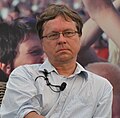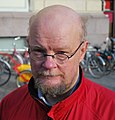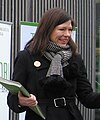Green League
| Abbreviation | VIHR |
|---|---|
| Chairperson | Touko Aalto |
| Secretary | Lasse Miettinen |
| Interim secretary | Kaisa Hernberg |
| Vice-chairperson | Maria Ohisalo |
| Vice-chairperson | Hanna Halmeenpää |
| Vice-chairperson | Veli Liikanen |
| Speaker of the party delegation | Kaisa Hernberg |
| Founded | 28 February 1987 |
| Legalized | 1988 |
| Headquarters | Fredrikinkatu 33, Helsinki |
| Newspaper | Vihreä Lanka |
| Youth wing | ViNO |
| Women's wing | Vihreät naiset |
| Membership (2013) | 8,034[1] |
| Ideology | Green politics[2][3][4] Pro-Europeanism |
| Political position | Centre-left[5][6] |
| European affiliation | European Green Party |
| European Parliament group | The Greens–European Free Alliance |
| International affiliation | Global Greens |
| Colors | Green |
| Slogan | Neljän vuodenajan puolesta |
| Eduskunta | 15 / 200
|
| European Parliament | 1 / 13
|
| Municipalities | 536 / 8,999
|
| Website | |
| https://www.vihreat.fi/ | |
| Part of a series on |
| Green politics |
|---|
 |
The Green League (VIHR, Template:Lang-fi, Template:Lang-sv), shortened to the Greens,[7] is a green political party in Finland.[2][3][4] The Green League is among the largest political parties in Finland. The Greens hold fifteen seats in the Finnish Parliament and one in the European Parliament. The party is a member of the Global Greens and the European Green Party, while its MEP, Heidi Hautala, sits with The Greens–European Free Alliance in the European Parliament. Originally split on whether Finland should join the European Union, the Green League is pro-European and was the first Finnish party in favor of the federalisation of the European Union.[8]
Founded in 1987, the party absorbed a number of green organisations and their members, including four MPs elected in 1987. The party won ten seats in the 1991 election. Despite falling to nine seats in 1995 election, Pekka Haavisto joined Paavo Lipponen's first cabinet, which was composed of a rainbow coalition. This move made the Green League the first green party in a national cabinet. The party remained in government until 2002, when it resigned from the cabinet in opposition to nuclear power. In 2007, the party peaked at 15 seats, and joined the centre-right-led government. At the 2011 election, the party fell to ten seats. Nevertheless, the Greens were invited to join the six-party Katainen Cabinet. In the 2015 parliamentary election, the party returned to its previous best of 15 seats, and at 8.53%, achieved their best ever share of the overall vote.
Since June 2017, the party’s leader and chairman has been Touko Aalto. The party is in opposition, and has provided vast criticism regarding the actions of the incumbent right-wing Sipilä Cabinet such as financial support for economically well-off companies, Fortum's purchase of Uniper, and the expedited process of constitution-changing surveillance laws.[9][10][11]
History
Founding
The Green League was founded 28 February 1987, and was registered as a political party the next year. Political activity had begun already in the early 1980s, when environmental activists, feminists, disillusioned young politicians from the marginalized Liberal People's Party and other active groups began to campaign on green issues in Finland. In 1995, it was the first European green party to be part of a state-level cabinet.
The party was founded as a popular movement, which explains its name's descriptor liitto, "league". Initially, there was much resistance within the movement against the founding of a political party, motivated by Robert Michels' iron law of oligarchy, which claims that movements inevitably degenerate into oligarchies when they create a formal organization.[12] The party still especially stresses openness and democratic decision-making. Even though liitto has been dropped from the party's website and advertisements, the word still remains in the official name.
Early activities (1983-1994)
The first two parliamentary representatives were elected even before the registration, in the 1983 parliamentary election. These were the first independent representatives in the Finnish Parliament. In 1987 the number of seats rose to four, and in 1991 to ten.
About half of the party’s members were against Finland joining the European Union in 1994. Later, polls showed that most Greens were anti-Eurozone.[13] The party heads declined to fight against euro adoption.
As part of the Lipponen Cabinets (1995-2003)
In the 1995 election, the Green League received a total of nine seats out of 200. The party joined the coalition cabinet led by the Social Democrats, and Pekka Haavisto became the Minister of the Environment,[14] thus becoming the first green minister in Europe.[citation needed]
The Green League received 7.3% of the vote, and gained two additional seats in the 1999 election, raising the total to 11. The Greens continued in the next coalition cabinet, but resigned in protest on 26 May 2002, after the cabinet's decision to allow the construction of a new nuclear plant was accepted by Parliament.
Growth to mainstream appeal (2003-present)
In 2003, the Green League received 8.0% of the vote, receiving a total of 14 seats. They increased their seats to 15 in the 2007 election, while receiving 8.5% of the vote. In the 2011 election, the party lost five seats.
In the 2009 European Parliament elections, the Greens gained two of the thirteen Finnish seats in the European Parliament, which were occupied by Satu Hassi and Heidi Hautala.
At the municipal level, the Greens are an important player in the largest cities of Finland. In the municipal election of 2008 the Greens received 8.9% of the vote; the vote share was considerably higher in Helsinki, where the Greens became the second largest party with 23.2% of the vote.[15] In several other cities, the Greens achieved the position of the third largest party. Its weak spot is the rural countryside, particularly in those municipalities experiencing strong outward migration.
A 2012 study indicated that the Greens are the most popular party among journalists.[16]
In 2017, the party's then-chairperson Ville Niinistö announced that he would step down as chair of the Green League in June 2017. The statement caused a leadership election. There were six candidates running for party chair, of whom MP Touko Aalto won the election.[17]
Ideology and policies

The Green League is no longer a protest party, nor an alternative movement. Some Green candidates reject classifying the party as either left-wing or right-wing. Economic opinions of the members range between left and right.[12] However, on average, members of party place their party left of the Social Democrats and right of the Left Alliance.[18] In comparison with some other European green parties, Finland's Greens are noticeably more pro-European and centrist.
In the chamber of the Parliament and assembly rooms of local councils, Green representatives sit between the Finns and the Social Democrats.
The party is one of the strongest proponents for same-sex marriage. The party is also distinct in its opposition against universal male conscription and wants to opt for a gender-neutral, selective version. The eventual goal of the Greens is voluntary military service.
In 2015, the party included universal basic income as a proposal in their platform.[19]
Elections results
Parliamentary elections

| Election year | # of overall votes | % of overall vote | # of overall seats won | +/- | Notes |
|---|---|---|---|---|---|
| 1983 | 43,754 | 1.47 | 2 / 200
|
||
| 1987 | 115,988 | 4.03 | 4 / 200
|
||
| 1991 | 185,894 | 6.82 | 10 / 200
|
||
| 1995 | 181,198 | 6.52 | 9 / 200
|
||
| 1999 | 194,846 | 7.27 | 11 / 200
|
||
| 2003 | 223,846 | 8.01 | 14 / 200
|
||
| 2007 | 234,429 | 8.46 | 15 / 200
|
||
| 2011 | 213,172 | 7.25 | 10 / 200
|
||
| 2015 | 253,102 | 8.53 | 15 / 200
|
Municipal elections

| Year | Councillors | Votes | Share of votes |
|---|---|---|---|
| 1984 | 101 | 76,441 | 2.8% |
| 1988 | 94 | 61,581 | 2.3% |
| 1992 | 343 | 184,787 | 6.9% |
| 1996 | 292 | 149,334 | 6.3% |
| 2000 | 338 | 171,707 | 7.7% |
| 2004 | 313 | 175,933 | 7.4% |
| 2008 | 370 | 228,277 | 8.9% |
| 2012 | 323 | 213,100 | 8.5% |
| 2017 | 534 | 320,235 | 12.5% |
European Parliament elections
| Election year | # of overall votes | % of overall vote | # of overall seats won | +/- | Notes |
|---|---|---|---|---|---|
| 1996 | 170,670 | 7.6 | 1 / 16
|
||
| 1999 | 166,786 | 13.4 | 2 / 16
|
||
| 2004 | 172,844 | 10.4 | 1 / 14
|
||
| 2009 | 206,439 | 12.4 | 2 / 13
|
||
| 2014 | 160,967 | 9.3 | 1 / 13
|
Presidential elections
Parliamentarian and then-former MEP Heidi Hautala was a candidate in the presidential elections in 2000 and 2006, taking approximately a 3.5% share of votes in the first round in each. Pekka Haavisto was the first Green candidate in the 2012 election to enter the second round. Haavisto got an 18.8% share of votes in the first round, and lost to centre-right Sauli Niinistö in the second round held on 5 February.
| Election year | Candidate | 1st round | 2nd round | ||
|---|---|---|---|---|---|
| # of overall votes | % of overall vote | # of overall votes | % of overall vote | ||
| 2000 | Heidi Hautala | 100,740 | 3.3 (#5) | ||
| 2006 | Heidi Hautala | 105,248 | 3.5 (#4) | ||
| 2012 | Pekka Haavisto | 574,275 | 18.8 (#2) | 1,077,425 | 37.4 (#2) |
| 2018 | Pekka Haavisto | 370,823 | 12.4 (#2) | ||
Politicians
List of party chairs
-
Kalle Könkkölä
(1987) -
Heidi Hautala
(1987–1991) -
Pekka Sauri
(1991–1993) -
Pekka Haavisto
(1993–1995) -
Tuija Brax
(1995–1997) -
Satu Hassi
(1997–2001) -
Osmo Soininvaara
(2001–2005) -
Tarja Cronberg
(2005–2009) -
Anni Sinnemäki
(2009–2011) -
Ville Niinistö
(2011–2017) -
Touko Aalto
(2017–)
Current members of Parliament
The following 15 Greens politicians were elected to the Finnish Parliament in the 2015 parliamentary election.[20]
Current members of the European Parliament
Since 2014, the Green League has been represented by one MEP in the European Parliament.
See also
References
- ^ STT (2011-02-07). "Vihreiden jäsenmäärä kasvanut räjähdysmäisesti - HS.fi - Politiikka" (in Finnish). HS.fi. Archived from the original on 2013-11-04. Retrieved 2013-12-23.
{{cite web}}: Unknown parameter|deadurl=ignored (|url-status=suggested) (help) - ^ a b Nordsieck, Wolfram (2015). "Finland". Parties and Elections in Europe.
- ^ a b Claire Annesley (11 January 2013). Political and Economic Dictionary of Western Europe. Routledge. pp. 177–. ISBN 978-1-135-35547-0.
- ^ a b Daniele Caramani (29 March 2004). The Nationalization of Politics: The Formation of National Electorates and Party Systems in Western Europe. Cambridge University Press. pp. 303–. ISBN 978-0-521-53520-5.
- ^ Lane, Jan-Erik; Svante Ersson (2008). "The Nordic Countries". In Colomer, Josep Maria (ed.). Comparative European politics. Taylor & Francis. p. 260. ISBN 978-0-415-43755-4.
- ^ Josep M. Colomer (25 July 2008). Political Institutions in Europe. Routledge. pp. 260–. ISBN 978-1-134-07354-2.
- ^ "Yle party poll: Centre recovers as Greens, Finns Party falter". Yle Uutiset. Retrieved 2017-11-12.
- ^ Raunio, Tapio; Tiilikainen, Teija (2003). Finland in the European Union. London: Routledge. p. 52. ISBN 978-0-7146-5375-4.
- ^ "Nyt on oikea aika uudistaa perhevapaat ja yritystuet". Vihreät - De Gröna (in Finnish). 2017-06-27. Retrieved 2018-02-03.
- ^ "Fortumin Uniper-kauppa vesittää puhtaat lupaukset". Vihreät - De Gröna (in Finnish). 2017-10-09. Retrieved 2018-02-03.
- ^ "Perustelut tiedustelulain kiirehtimiselle puuttuvat". Vihreät - De Gröna (in Finnish). 2018-01-31. Retrieved 2018-02-03.
- ^ a b Rauli Mickelsson. Suomen puolueet - Historia, muutos ja nykypäivä. Vastapaino 2007, 429 pages.
- ^ "4.2 Suomi Euroopan Unionissa".
- ^ "Composition of a certain government, 66. Lipponen". Valtioneuvosto. Retrieved 2018-01-18.
- ^ "Vaalit 2008 tulospalvelu - Helsinki - Puolueiden kannatus" (in Finnish). Yle.fi. 2008-10-30. Retrieved 2013-12-23.
- ^ "Aamulehti" (in Finnish). Aamulehti.fi. Retrieved 2013-12-23.
- ^ "Touko Aalto vihreiden puheenjohtajaksi" (in Finnish). Vihreät. 17 June 2017. Retrieved 17 June 2017.
- ^ Elo, Kimmo – Rapeli, Lauri (2008): Suomalaisten politiikkatietämys. Oikeusministeriön julkaisuja 2008:6.
- ^ "Vihreät haluaa 560 euron perustulon kaikille". Kaleva.fi. Retrieved 24 February 2015.
- ^ "Eduskuntavaalit 2015". Yle. Retrieved 22 April 2015.






















